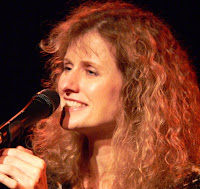Cathie Ryan: Irish and American


Singer and songwriter Cathie Ryan builds bridges between Ireland and America, between past and present, and between the stuff of daily life and the spiritual and emotional dimensions that give that day to day another dimension.
Ryan makes her home in Ireland now; she grew up in Detroit. Her parents had emigrated to the motor city and they brought their music with them. "It was a way for them to stay connected to home, to Ireland, and music was a way for us kids to stay connected to them," Ryan says. "They loved music, it was always, always playing. You know how in the old days of vinyl, there used to be this great weight of records, and every record would plop down? It was Irish traditional music, and then more mainstream stuff like the Clancy Brothers and Tommy Makem, and then Johnny Cash, and Merle Haggard, and Creedence Clearwater Revival -- it was great!"
Outside the house, the young Ryan found the music of Motown, her best friend's country and Appalachian favorites, Van Morrison on her transistor radio, and on summer visits back to Ireland, her grandmother's fiddling and singing, and her grandfather's telling of stories. "My grandmother Catherine Ryan was a singer, and a fiddle player. She loved to sing and play, she loved having people come into the house and pushing back the furniture. Then my mother's father was a storyteller," Ryan continued, "and he was the one who gave me my love of narrative. He told stories of the history of Ireland, the mythology, and the characters, what this one did and what that one did. For him there was a very, very thin line between this world and and the other world, and he had one foot in each of them."
Ryan took all this in, and after relocating to New York to study for a teaching degree in English, she also began studying traditional sean nos style singing with acclaimed master singer Joe Heaney from Connemara. He was "a gem, a real gem. I was singing at a time before traditional music became so popular, and I wanted to sing traditional sean nos and the audiences really wanted to hear much more commercial material. I didn't know it and I didn't want to sing it, so I found it very hard to have an audience, and then, when I went to Ireland to compete in the All Ireland, I was told from the stage by a judge that no American could win an all Ireland because they weren't native, and really you had to live in Ireland to be an authentic singer." When Ryan told Heaney of the comment, "he just went off on the whole adjudicating system," she said, and encouraged her by saying, " 'don't you ever stop singing, never mind them, you sing what's in you, you're a beautiful singer, and don't let anybody stop you.' Hearing that from him meant the world to me, it just meant the world to me," Ryan recalled. Though Ryan's tastes in music have evolved to include singing and creating music beyond sean nos, she carries with her another idea that work with the legendary musician led her to. "I don't like to show off," she said. "I like to sing the song whatever way it wants to be sung. I believe that a song is a real entity that must be courted and loved, that you have to find a place for it in your own center and bring it up from there when you sing it."
That is an idea Ryan has followed through a seven year stint as lead singer with the acclaimed Celtic band Cherish the Ladies, and since setting out as a solo artist in 1995, through four albums and counting, music which combines songs from the tradition in both English and Irish, songs from the American side of her folk heritage, music from contemporary writers including Luka Bloom, Karine Polwart, and John Spillane, and songs Ryan writes herself. In her own writing, she has moved from telling of characters and events of history - the struggling immigrant of The Back Door, a track she recorded in 1992 for a Cherish the Ladies album of the same name, Grace O'Malley, a look at Ireland's pirate queen which is just a feisty as she likely was; Rathlin Island, an emigration song with history and present day of those who stayed behind; and In My Tribe, a consideration of the connection and duality of roots and rootedness framed in the landscapes of rural Ireland and the desert southwest of the United States - to reflections on pain, healing, and the courage it takes to do so, in the very different songs The Farthest Wave, Be Like the Sea, and What's Closest to the Heart. Ryan explores both the light and darkness of her dual heritage in Ireland and America, and creates music that invites listeners, as well, to consider what it means to be both Irish and American -- and human.
content at Music Road, both text and images, is copyrighted. thank you for respecting this.
you may also wish to see
The Farthest Wave
2010 Songwriter's Market: Where & How to Market Your Songs Ryan talks about her songwriting and gives a bit of the story behind creating several of her most loved songs
Music Road: ceol chairlinn: sharing music in winter
Irish music, Irish landscape
Ryan's tour schedule is available at her web site
-->Your support for Music Road is welcome and needed. If you are able to chip in, here is a way to do that, through PayPal. Note that you do not have to have a PayPal account to do this. Thank you.
Labels: american folk music, cathie ryan, ireland, Irish American, irish music, singer, songwriter







0 Comments:
Post a Comment
Subscribe to Post Comments [Atom]
<< Home